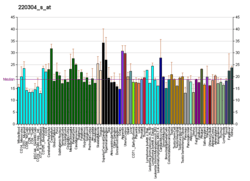Cyclic nucleotide gated channel beta 3
Cyclic nucleotide gated channel beta 3, also known as CNGB3, is a human gene encoding an ion channel protein.[5]
See also
- Cyclic nucleotide-gated ion channel
- Stargardt disease
References
- GRCh38: Ensembl release 89: ENSG00000170289 - Ensembl, May 2017
- GRCm38: Ensembl release 89: ENSMUSG00000056494 - Ensembl, May 2017
- "Human PubMed Reference:". National Center for Biotechnology Information, U.S. National Library of Medicine.
- "Mouse PubMed Reference:". National Center for Biotechnology Information, U.S. National Library of Medicine.
- "Entrez Gene: CNGB3 cyclic nucleotide gated channel beta 3".
Further reading
- Hofmann F, Biel M, Kaupp UB (2006). "International Union of Pharmacology. LI. Nomenclature and structure-function relationships of cyclic nucleotide-regulated channels". Pharmacol. Rev. 57 (4): 455–62. doi:10.1124/pr.57.4.8. PMID 16382102.
- Koenekoop RK, Lopez I, den Hollander AI, et al. (2007). "Genetic testing for retinal dystrophies and dysfunctions: benefits, dilemmas and solutions". Clin. Experiment. Ophthalmol. 35 (5): 473–85. doi:10.1111/j.1442-9071.2007.01534.x. PMID 17651254.
- Pentao L, Lewis RA, Ledbetter DH, et al. (1992). "Maternal uniparental isodisomy of chromosome 14: association with autosomal recessive rod monochromacy". Am. J. Hum. Genet. 50 (4): 690–9. PMC 1682625. PMID 1347967.
- Winick JD, Blundell ML, Galke BL, et al. (1999). "Homozygosity mapping of the Achromatopsia locus in the Pingelapese". Am. J. Hum. Genet. 64 (6): 1679–85. doi:10.1086/302423. PMC 1377911. PMID 10330355.
- Sundin OH, Yang JM, Li Y, et al. (2000). "Genetic basis of total colourblindness among the Pingelapese islanders". Nat. Genet. 25 (3): 289–93. doi:10.1038/77162. PMID 10888875.
- Kohl S, Baumann B, Broghammer M, et al. (2000). "Mutations in the CNGB3 gene encoding the beta-subunit of the cone photoreceptor cGMP-gated channel are responsible for achromatopsia (ACHM3) linked to chromosome 8q21". Hum. Mol. Genet. 9 (14): 2107–16. doi:10.1093/hmg/9.14.2107. PMID 10958649.
- Peng C, Rich ED, Thor CA, Varnum MD (2003). "Functionally important calmodulin-binding sites in both NH2- and COOH-terminal regions of the cone photoreceptor cyclic nucleotide-gated channel CNGB3 subunit". J. Biol. Chem. 278 (27): 24617–23. doi:10.1074/jbc.M301699200. PMID 12730238.
- Peng C, Rich ED, Varnum MD (2003). "Achromatopsia-associated mutation in the human cone photoreceptor cyclic nucleotide-gated channel CNGB3 subunit alters the ligand sensitivity and pore properties of heteromeric channels". J. Biol. Chem. 278 (36): 34533–40. doi:10.1074/jbc.M305102200. PMID 12815043.
- Johnson S, Michaelides M, Aligianis IA, et al. (2004). "Achromatopsia caused by novel mutations in both CNGA3 and CNGB3". J. Med. Genet. 41 (2): 20e–20. doi:10.1136/jmg.2003.011437. PMC 1735666. PMID 14757870.
- Peng C, Rich ED, Varnum MD (2004). "Subunit configuration of heteromeric cone cyclic nucleotide-gated channels". Neuron. 42 (3): 401–10. doi:10.1016/S0896-6273(04)00225-9. PMID 15134637.
- Michaelides M, Aligianis IA, Ainsworth JR, et al. (2004). "Progressive cone dystrophy associated with mutation in CNGB3". Invest. Ophthalmol. Vis. Sci. 45 (6): 1975–82. doi:10.1167/iovs.03-0898. PMID 15161866.
- Okada A, Ueyama H, Toyoda F, et al. (2004). "Functional role of hCngb3 in regulation of human cone cng channel: effect of rod monochromacy-associated mutations in hCNGB3 on channel function". Invest. Ophthalmol. Vis. Sci. 45 (7): 2324–32. doi:10.1167/iovs.03-1094. PMID 15223812.
- Kohl S, Varsanyi B, Antunes GA, et al. (2005). "CNGB3 mutations account for 50% of all cases with autosomal recessive achromatopsia". Eur. J. Hum. Genet. 13 (3): 302–8. doi:10.1038/sj.ejhg.5201269. PMID 15657609.
- Nishiguchi KM, Sandberg MA, Gorji N, et al. (2006). "Cone cGMP-gated channel mutations and clinical findings in patients with achromatopsia, macular degeneration, and other hereditary cone diseases". Hum. Mutat. 25 (3): 248–58. doi:10.1002/humu.20142. PMID 15712225.
- Varsányi B, Wissinger B, Kohl S, et al. (2006). "Clinical and genetic features of Hungarian achromatopsia patients". Mol. Vis. 11: 996–1001. PMID 16319819.
- Bright SR, Brown TE, Varnum MD (2006). "Disease-associated mutations in CNGB3 produce gain of function alterations in cone cyclic nucleotide-gated channels". Mol. Vis. 11: 1141–50. PMID 16379026.
- Bright SR, Rich ED, Varnum MD (2007). "Regulation of human cone cyclic nucleotide-gated channels by endogenous phospholipids and exogenously applied phosphatidylinositol 3,4,5-trisphosphate". Mol. Pharmacol. 71 (1): 176–83. doi:10.1124/mol.106.026401. PMID 17018579.
- Wiszniewski W, Lewis RA, Lupski JR (2007). "Achromatopsia: the CNGB3 p.T383fsX mutation results from a founder effect and is responsible for the visual phenotype in the original report of uniparental disomy 14". Hum. Genet. 121 (3–4): 433–9. doi:10.1007/s00439-006-0314-y. PMID 17265047.
External links
- GeneReviews/NIH/NCBI/UW entry on Achromatopsia
- OMIM entries on Achromatopsia
- CNGB3+protein,+human at the US National Library of Medicine Medical Subject Headings (MeSH)
This article incorporates text from the United States National Library of Medicine, which is in the public domain.
This article is issued from Wikipedia. The text is licensed under Creative Commons - Attribution - Sharealike. Additional terms may apply for the media files.




